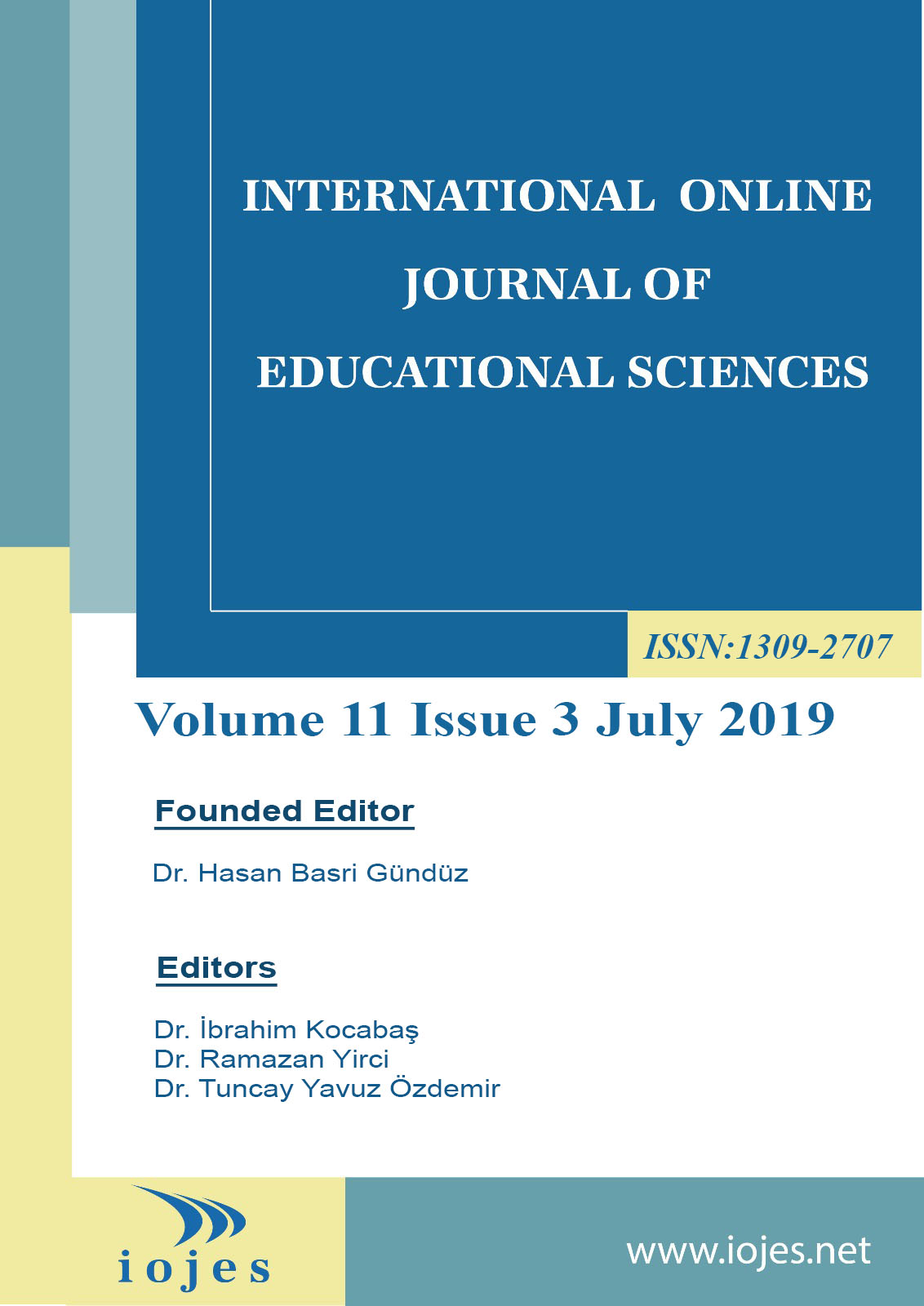How Fifth Graders Are Assessed Through Central Exams in Turkey: A Comparison with TIMSS 2019 Assessment Framework
Author :
Abstract
Keywords
Abstract
In this study, Turkish fifth-grade bursary examination mathematics items, all of which are of multiple choice, from years 1999 to 2018 are analyzed based on the cognitive and content domains of TIMSS 2019 assessment framework. According to document analysis of the data collected through official website of Ministry of National Education, the distribution of the cognitive demands of all items indicates that there is an emphasis on applying or reasoning domain with about 74%. This result leads to the conclusion that Turkish fifth-grade mathematics items require upper cognitive demands comparing with TIMSS target percentages. Also, it is observed that there are dramatic changes in cognitive demands of the items from year to year which may mean that there is no framework followed for the bursary examinations. Examining the content domains of the bursary examination, findings reveal that the majority of the items are in numbers (60%), and it is followed by measurement and geometry (34%), and data (6%), which are similar with the target percentages of TIMSS 2019 that are 50, 35, and 15 respectively. Finally, suggestions are given in the light of findings and educational reforms in Turkey.
Keywords
- Anderson, L.W. (Ed.), Krathwohl, D.R. (Ed.), Airasian, P.W., Cruikshank, K.A., Mayer, R.E., Pintrich, P.R., Raths, J. and Wittrock, M.C. (2001). A taxonomy for learning, teaching, and assessing: A Revision of Bloom's Taxonomy of Educational Objectives. (Complete edition). New York: Longman.
- Ben-Simon, A. and Cohen, Y. (2004). International assessments: Merits and pitfalls. Proceedings of the 30th Annual Conference of the International Association for Educational Assessment (IAEA). Philadelphia, June 2004.
- Bloom, B.S. (Ed.), Engelhart, M.D., Furst, E.J., Hill, W.H. and Krathwohl, D.R. (1956). Taxonomy of Educational Objectives, the classification of educational goals – Handbook I: Cognitive Domain. New York: David McKay.
- Çelik, S., Kul, Ü. and Çalık Uzun, S. (2018). Using Bloom’s revised taxonomy to analyse learning outcomes in mathematics curriculum. Abant İzzet Baysal Üniversitesi Eğitim Fakültesi Dergisi, 18 (2), 775-795.
- Delil, A. and Yolcu Tetik, B. (2015). An analysis of Turkish eighth grade high stakes mathematics examination questions based on TIMSS-2015 framework. MCBU Sosyal Bilimler Dergisi, Cilt:13, S.4, Doi Number: 10.18026/cbusos.87313.
- Delil, A., Özcan, B.N. and Işlak, O. (2018). Yeni İlkokul Matematik Dersi Öğretim Programı Kazanımlarının TIMSS-2015 Çerçevesine Göre Değerlendirilmesi. (An Analysis of the New Turkish Mathematics Curriculum Acquisitions in Terms of TIMSS-2015 Assessment Frameworks). VIII. International Congress on Research in Education. 9-11 May 2018, Manisa.
- Delil, H. (2006). An Analysis of Geometry Problems in 6-8 Grades Turkish Mathematics Textbooks. (Master thesis). Middle East Technical University, Ankara.
- EMBE (2019). MEB IOKBS Başvuru ve Uygulama e-Kılavuzu (Ministry of National Education Elementary and Middle-school Bursary Examinations E-guide). Retrieved on 15.03.2019 from http://www.meb.gov.tr/ meb_iys_dosyalar/2019_03/11110605_bursluluk_ekilavuz_2019_.pdf
- Incikabi, L. (2012). After the reform in Turkey: A content analysis of SBS and TIMSS assessment in terms of mathematics content, cognitive domains, and item types. Education as Change, 16:2, 301-312.
- Marzano, R.J. and Kendall, J.S. (2008). Designing and Assessing Educational Objectives: Applying the New Taxonomy. Corwin Press.
- MONE (2016). TIMSS 2015 Ulusal Matematik ve Fen Ön Raporu: 4. ve 8. Sınıflar (TIMSS 2015 National Mathematics and Science Report: 4th and 8th graders). Ministry of National Education, Ankara.
- Mullis, I.V.S., and Martin, M.O. (Eds.) (2017). TIMSS 2019 Assessment Frameworks. Retrieved from Boston College, TIMSS and PIRLS International Study Center website: http://timssandpirls.bc.edu/timss2019/ frameworks/
- Neuendorf, K.A. (2002). The content analysis guidebook. Sage Publications.
- Nitko, A. J. (2004). Educational assessment of students. Pearson Merrill-Hill, NJ: Upper Saddle Rive.
- Taştekinoğlu, E. and Aydın, G. (2014). 4. Sınıf Matematik Sınav Sorularının TIMSS 2011 Bilişsel Alanları ve Öğretim Programlarıyla Karşılaştırılması. (A Comparison of Fourth Grade Mathematics Examinations with TIMSS 2011 Cognitive Domains and Mathematics Curricula). III. Türkiye Lisansüstü Çalışmalar Kongresi Bildiriler Kitabı - I (Sosyoloji - İlahiyat - Eğitim), 15-18 Mayıs 2014, Sakarya. Retrieved on 07.02.2019 from http://tlck.org.tr/wp-content/uploads/2018/09/III_TLCK_1_kitap_BASKI.pdf
- TIMSS (2009). TIMSS-2007 Released Items. Retrieved on 19.05.2012 from http://timss.bc.edu/timss2007/ items.html
- TIMSS (2013). TIMSS-2011 Released Items. Retrieved on 19.02.2019 from https://timssandpirls.bc.edu/ timss2011/international-released-items.html
- Wilson, V. (2000). Can thinking skills be taught? Retrieved on 19.08.2013 from http://www.peopledev.co.za /library/can_think_skill_be_taught.pdf%E2%80%8E
- Woessmann, L. (2002). How Central Exams Affect Educational Achievement: International Evidence from TIMSS and TIMSS-Repeat. A paper prepared for the conference Taking Account of Accountability: Assessing Politics and Policy. John F. Kennedy School of Government Harvard University (June 10 – 11, 2002).
- Woessmann, L. (2003). Central Exams as the "Currency" of School Systems: International Evidence on the Complementarity of School Autonomy and Central Exams, CESifo DICE Report, ISSN 1613-6373, ifo Institut für Wirtschaftsforschung an der Universität München, München, Vol. 01, Iss. 4, pp. 46-56.
